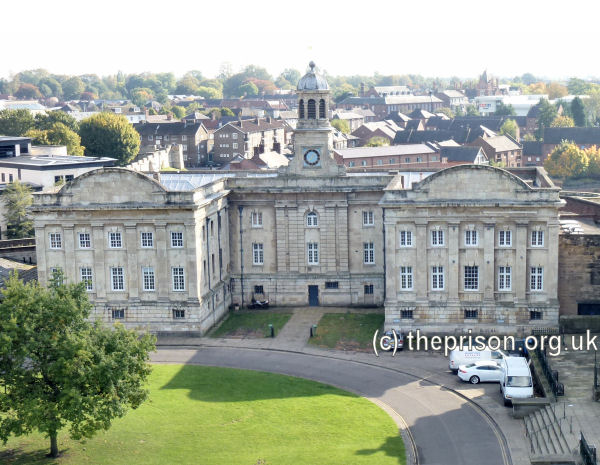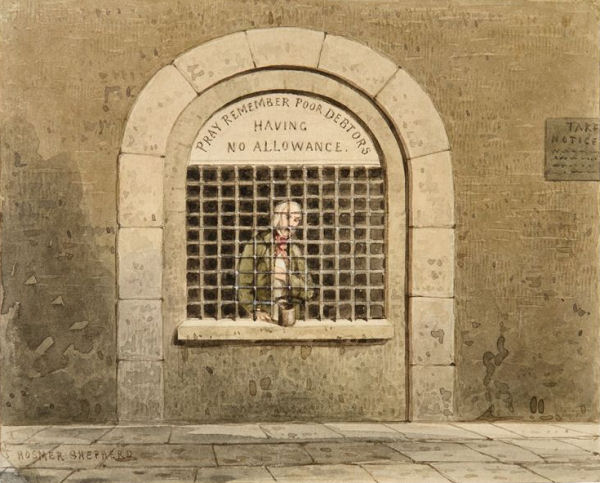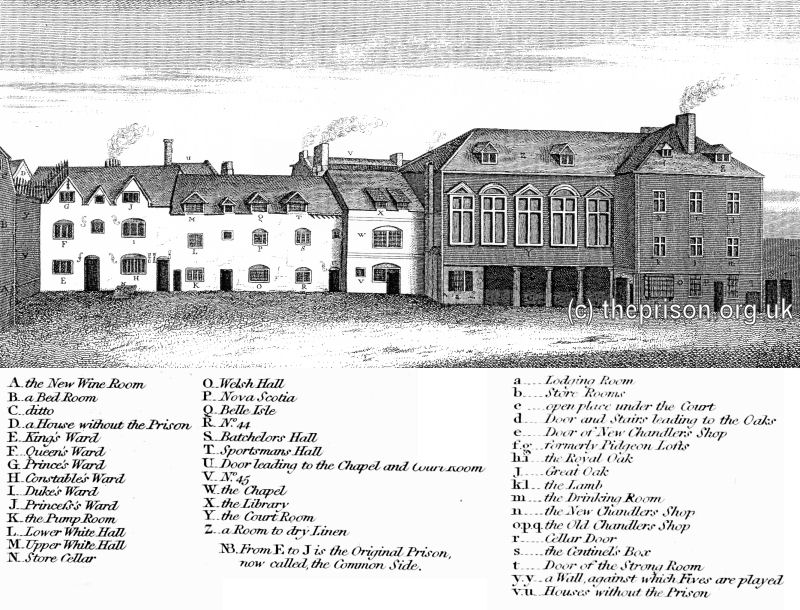Debtors' Prisons
The use of imprisonment for debtors to the Crown, which began in 1178, was extended to all debtors in 1352. By the 18th century, over half the population of England's prisoners were in jail because of debt.
As well as being held in prisons used solely for the purpose, debtors were also often housed in other types of prison such as a county or town gaol.

Former Debtors' Prison York, 2015. © Peter Higginbotham
The fees and living expenses that were required from prisoners placed debtors in a particularly hard position. The charges accumulated while they were in prison would usually need to be settled before the debtor could leave prison. For a debtor without outside friends, this could amount to a life sentence.
Debtors were supposed to receive enough money from their creditors to provide them with bread and water. Even if this was forthcoming, which it was often not, the cost had to be repaid. Some prisons provided debtors with a basic subsistence. At Newgate in 1724, this comprised a daily ration of 'one coarse Houshold Wheaten Loaf, almost the Bigness of a common Penny White Loaf' plus a weekly portion of beef.
Debtors could generate a little income by performing work. A 1666 Act for the relief of poor prisoners gave magistrates powers to impose a rate with which a stock of material could be bought to provide employment for such people. Another source of assistance came through occasional legacies. Some prisons, such as London's Fleet, had a grille or grating facing the outside stride, through which friends or benevolent passers-by could leave a donation of money or food.

Begging grille, Fleet Prison, London.
Although debtors were often amongst the most wretched of a prison's inmates, some could use imprisonment to exploit their situation. So-called 'politic bankrupts' were those who obtained large amounts of goods or money on credit then feigned bankruptcy. When arrested they lived comfortably in prison and could often force a settlement on their creditors, paying only a proportion of the debt. Another group of debtors were those who voluntarily chose to remain in prison for rest of their lives. As debts were not inheritable, this sacrifice would free their heirs from any further claim.
The most notorious debtors' prisons were London's King's (Queen's) Bench,Fleet and Marshalsea prison, where corruption reigned. The gaolers paid considerable sums for the right to run these prisons and then extracted money from their inmates in whatever way they thought fit. In 1729, a parliamentary Select Committee found that the warders were in the regular habit of selling the "right of escape" to such as could afford their terms. Many persons indebted to the Crown for very large sums got away beyond the seas in this manner; and so carelessly were things conducted by the officials that no account was ever taken of the date of escape or the name of the person, much less any attempt made to recover the runaway. The Marshalsea and Fleet were finally closed in 1842, with their inmates being transferred to the Queen's Bench, which was itself closed in 1861.

Marshalsea Prison, Southwark, a debtors' prison in the 19th century. © Peter Higginbotham
The 1869 Debtors Act reduced the circumstances in which an individual could be imprisoned for debt and effectively brought and end to the debtors' prison. However, imprisonment for non-payment of debts was not fully abolished until the passing of the Administration of Justice Act in 1970.
Bibliography
- Higginbotham, Peter The Prison Cookbook: A History of the English Prison and its Food (2010, The History Press)
- Brodie, A. Behind Bars - The Hidden Architecture of England's Prisons (2000, English Heritage)
- Brodie, A., Croom, J. & Davies, J.O. English Prisons: An Architectural History (2002, English Heritage)
- Harding, C., Hines, B., Ireland, R., Rawlings, P. Imprisonment in England and Wales (1985, Croom Helm)
- McConville, Sean A History of English Prison Administration: Volume I 1750-1877 (1981, Routledge & Kegan Paul)
- Morris, N. and Rothman, D.G. (eds.) The Oxfod History of the Prison (1997, OUP)
- Pugh R.B. Imprisonment in Medieval England (1968, CUP)
Links
- Prison Oracle - resources those involved in present-day UK prisons.
- GOV.UK - UK Government's information on sentencing, probation and support for families.
Except where indicated, this page () © Peter Higginbotham. Contents may not be reproduced without permission.



